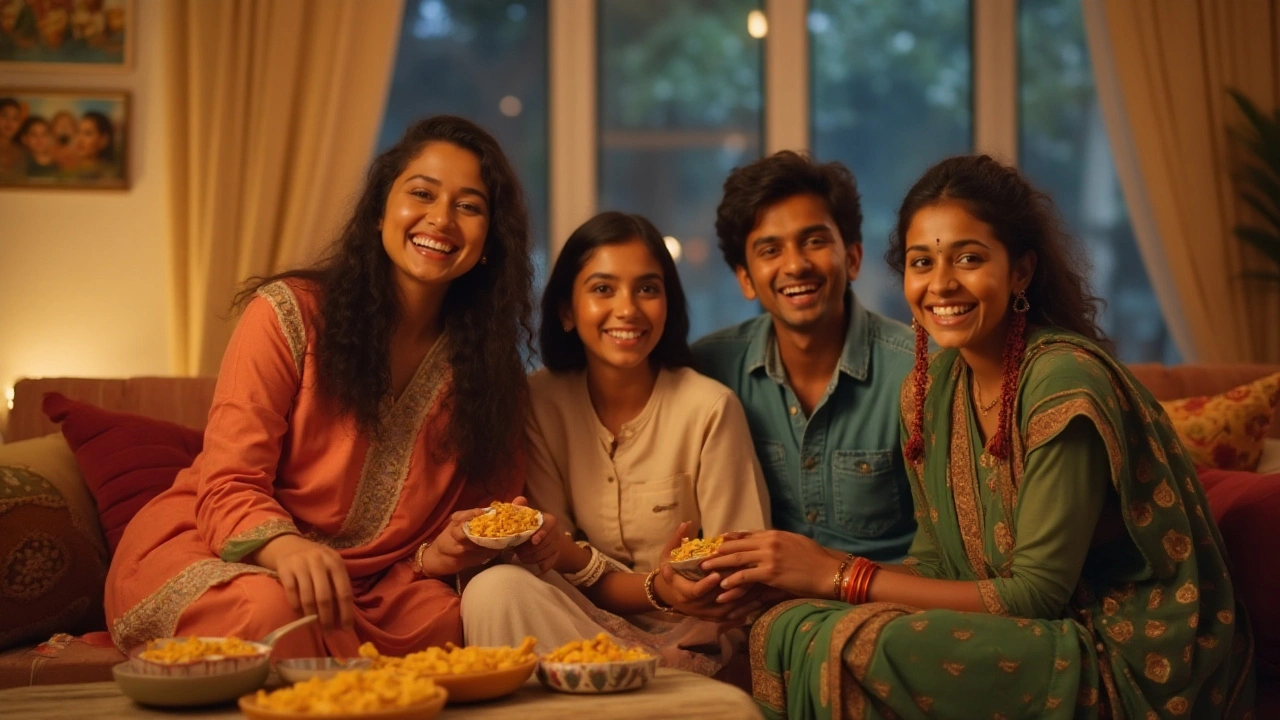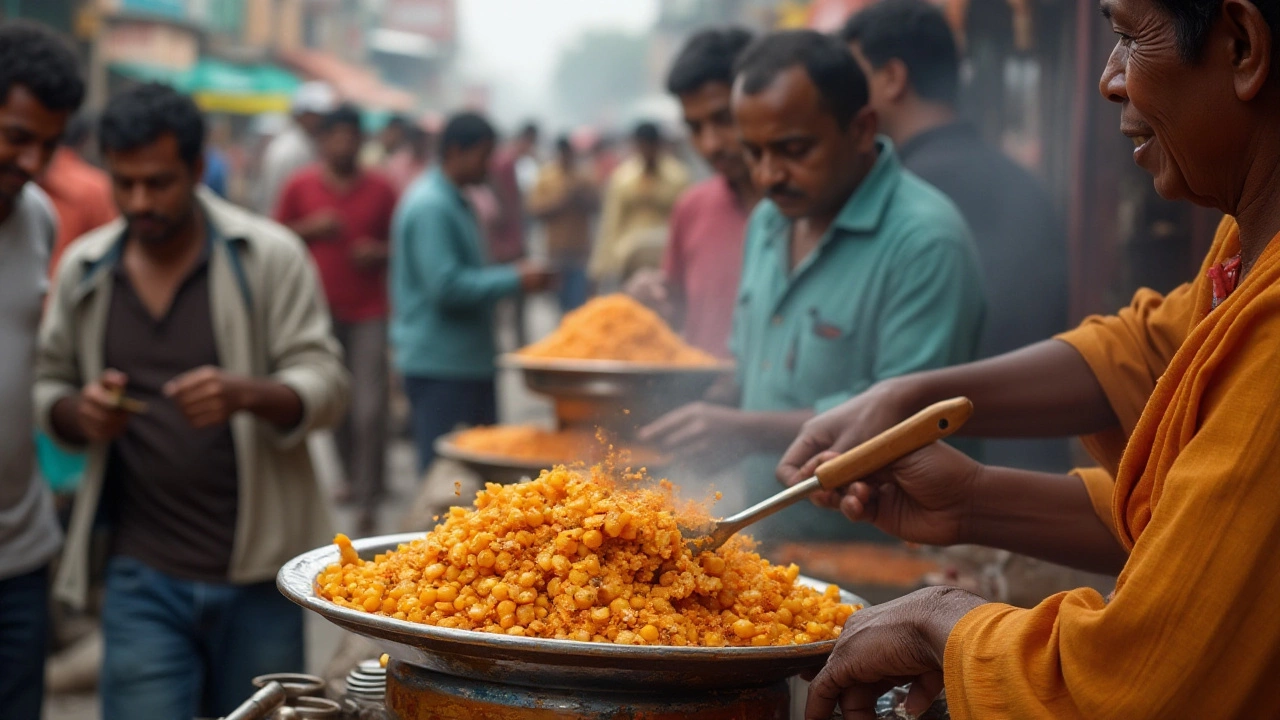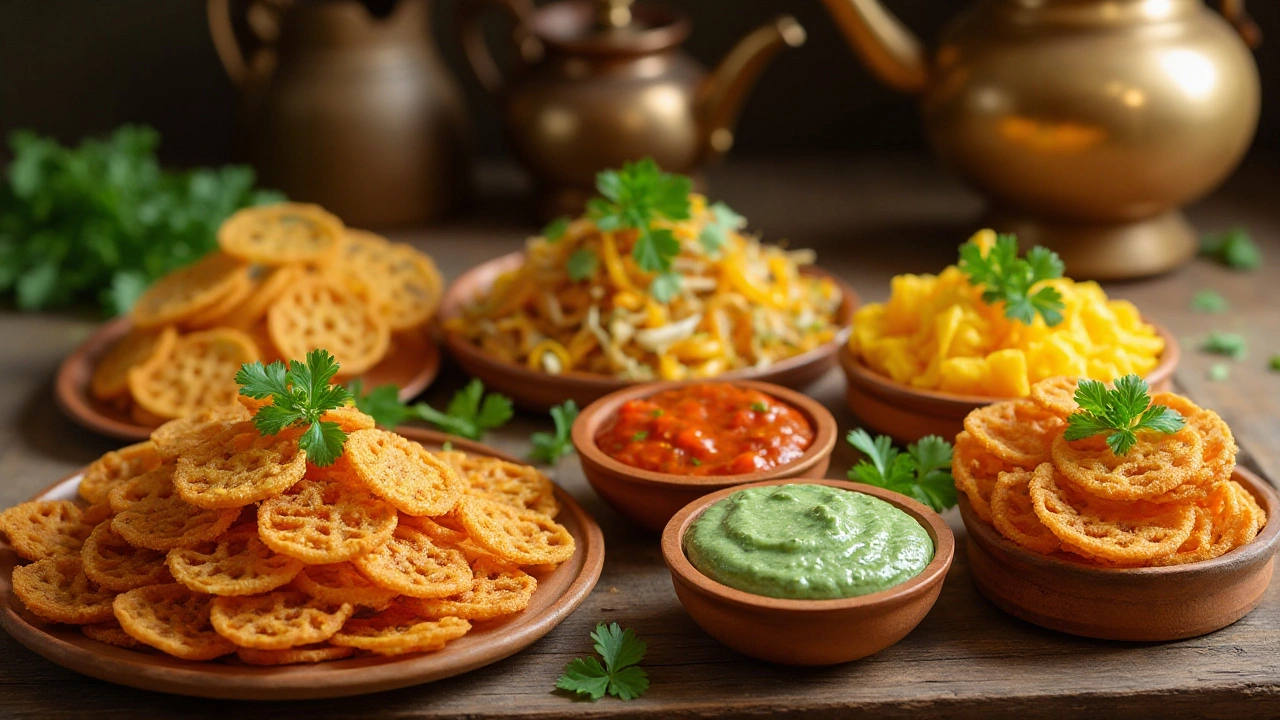India's rich culinary history has gifted the world with an array of mouthwatering snacks, each boasting unique flavors and textures. While these snacks are often associated with indulgence, many traditional options offer a healthy twist, perfectly balancing taste and nourishment.
This exploration into India's snack culture reveals the most popular and healthiest options enjoyed across the country. These snacks not only satisfy cravings but also provide essential nutrients, catering to the needs of health-conscious individuals. Let's dive into this delightful journey and discover how these snacks hold a special place in the daily life of Indians.
- Introduction to Indian Snack Culture
- The Rise of Healthy Snack Options
- Top Healthy Snacks in India
- Nutritional Benefits of Popular Snacks
- Incorporating Snacks into a Balanced Diet
- Tips for Choosing Healthier Snack Options
Introduction to Indian Snack Culture
India, a land of diversity, is celebrated for its cultural tapestry which is vividly reflected in its culinary landscape. Snacks, a vital part of Indian cuisine, play more than just a role of silencing hunger pangs. They are woven into the very social fabric of the country, punctuating festivals, gatherings, and everyday life with joy and flavor. From the bustling streets of Mumbai to the quaint alleyways in Kolkata, the variety of Indian snacks is as vast as it is fascinating. Historically, these snacks have evolved by absorbing influences from cultures that traded or invaded India, such as the Portuguese bringing with them the fiery chili that now peppers many snack dishes.
One cannot overlook the cultural significance of these snacks, often prepared with great care and shared generously among friends and family. Interestingly, some snacks even have symbolic meanings during specific festivals. For example, murukku, a crispy spiral snack, is a staple during Diwali in South India, representing the unending cycle of life and its joys. It's this intertwining of culture and cuisine that gives Indian snacks their unique charm. While some might associate snacks with unhealthy, greasy options, India showcases a different narrative where taste meets wellness.
In recent times, there's been a marked shift towards healthy snacks in India. The culinary landscape has embraced the idea of nutrition without compromising on taste. 'Chaat', for instance, has adapted beautifully with healthier versions using roasted chickpeas or sprouts with tangy mint chutney, making it not just a treat for the palate but also a source of proteins and fibers. This transformation highlights the creativity revolving around snack preparation, making it possible to indulge while maintaining good health. As a respected food historian once noted, "Indian snacks are much more than just a quick bite; they embody the history and complexity of Indian culinary tradition."
The love for snacks cuts across every stratum of society, fostering a sense of equality through shared enjoyment. Street vendors, revered for their skill and creativity, often craft these gastronomic delights that are affordable and accessible to all. Moreover, the tradition of snacking encourages communal eating, strengthening bonds and fostering relationships. Whether savoring a steaming plate of samosas during a monsoon shower or enjoying fresh sprout bhel on a hot summer's evening, these popular snacks of India become associated with memories, emotions, and the richness of life itself. The popularity of these snacks is not confined within Indian borders, as they are loved globally, receiving appreciation from all corners of the world.
The Rise of Healthy Snack Options
In recent years, India has witnessed a significant shift towards healthier eating habits, reflected in the growing popularity of nutritious and wholesome snacks. This transition is attributed to various factors including increased awareness about health and wellness, lifestyle changes, and a burgeoning middle class with disposable income to spend on healthier food choices. Traditional Indian snacks, long cherished for their rich flavors and cultural significance, are being reimagined in healthier forms to cater to a health-conscious audience.
Amidst this transformation, we see a widespread increase in the availability of healthy snacks made from ingredients like millets, nuts, and seeds. These alternatives provide a balance of essential nutrients without compromising on taste. More than ever, snack enthusiasts are opting for options like roasted flaxseeds, almond chivda, and jowar puffs. These mouthwatering delights not only satiate munching desires but also add fiber, proteins, and good fats to the daily diet, contributing to overall well-being.
It's worth noting that the rise of health-focused snack brands has played a pivotal role in this snack transformation. Brands like Yoga Bars and Snackible have created their niche by offering convenient, ready-to-eat snacks that emphasize natural ingredients, minimal processing, and no artificial additives. Such offerings have made it possible for busy urbanites to maintain a healthy lifestyle without sacrificing the pleasure of snacking. According to a report by the Federation of Indian Chambers of Commerce and Industry (FICCI), the health food market in India is expected to grow substantially over the next few years, highlighting the increasing demand for nutritious snack options.
Celebrated nutritionist Rujuta Diwekar once said, "Food is not just a commodity in India. It is a way of expressing love, culture, and identity. By reimagining traditional snacks, we're honoring our heritage while nurturing our future."
Perhaps another driving force behind this shift is the increasing health literacy of the Indian populace. As people become more savvy and informed about food labels and nutrition, they demand transparency and authenticity in their snack choices. Consumers are keenly aware of the benefits of whole grains, the importance of dietary fiber, and the pitfalls of caloric emptiness in processed foods. This knowledge fuels the search for snacks that are not just fillers but contributing partners to a balanced diet.
The rise of healthy snack options in India is a heartening development for those balancing the demands of a modern lifestyle with nutritional needs. It's an exciting time where innovation meets tradition, encouraging a harmonious blend of taste and health. Whether it's enjoying a bowl of makhana or grabbing a homemade energy bar on the go, today's snackers have more diverse and wholesome choices than ever before.

Top Healthy Snacks in India
India's culinary landscape is a vast tapestry, intricately woven with regional traditions and flavors, making it a paradise for snack enthusiasts. Among this array, some popular snacks have stood the test of time, revered not only for their taste but also for their health benefits. One such snack is the humble roasted chana, also known as Bengal gram. Packed with protein and fiber, roasted chana is a favorite among health-conscious individuals aiming to stay satiated without overindulging. This snack, often enjoyed with a sprinkle of salt and spices, provides a delightful crunch that pairs well with morning tea or as an afternoon pick-me-up.
Another beloved choice is the nutritious chaat – a category of savory snacks that can vary widely by region. A typical healthy chaat might consist of a mixture of sprouts, vegetables, and a sprinkle of tangy chutneys, offering a delightful symphony of textures and flavors. Chaats are not only filling but can be rich in vitamins and minerals, depending on the ingredients used. They're a testament to how traditional Indian flavors can merge with a health-forward approach. Each bite is a perfect blend of sweet, sour, and spicy, making it an irresistible snack across generations.
Murukku, a crunchy spiral made from rice and urad dal flour, is another favorite. Often found during festive occasions, this snack is loved for its subtle spicy taste and delightful texture. Rich in carbohydrates and boasting a decent amount of protein, murukku can be a healthier alternative to fried snacks, particularly when baked. It represents the innovative adaptations found in healthy snacks, capturing the balance between indulgence and nutrition.
Don't forget the classic idli, a steamed rice cake that serves as a versatile snack option. Typically enjoyed with coconut chutney or spicy sambar, idlis are low in calories and a great source of carbohydrates, essential for energy. These light morsels are ideal for those watching their waistlines, providing a feeling of fullness without unnecessary calories. The fermentation process used to make idlis also aids in digestion, offering probiotics that support gut health.
"Snacking in India is an art, and when done right, it brings both joy and nourishment to life," notes culinary expert Tarla Dalal.
While many urbanites lean towards these healthier options, traditional snacks hold their ground firmly in the hearts and stomachs of millions. The key is to prepare them in ways that preserve their inherent nutritional benefits while minimizing oil and excess seasoning. With an understanding of portion control and the power of spices, Indians can continue to savor these time-tested treasures as part of a balanced diet. This genuine enjoyment of hearty, wholesome snacks posits itself as a cultural celebration of both taste and health, bringing smiles to countless faces across the nation.
Nutritional Benefits of Popular Snacks
Indian snacks, while often regarded as indulgent, have a surprising side that caters to the health-conscious. With an evolving food landscape focusing on nutrition, Indian snacks like roasted chickpeas, bhel puri, and moong dal chaat prove to be both rewarding for the palate and the body. Roasted chickpeas, also known as chana, are a powerhouse of protein and fiber. They not only keep you full for longer periods but also aid in maintaining a healthy digestive system. On the other hand, bhel puri, a vibrant mix of puffed rice, sev, and tangy chutneys, offers an abundance of flavors without the calorie overload. It's a delightful way to consume antioxidants and fiber, especially when paired with fresh vegetables.
Another prominent player in the list of healthy snacks is moong dal chaat. This snack brings together lentils, which are a tremendous source of plant-based protein, with spices and lime, creating a nutrient-rich snack option. Lentils are known not only for their protein content but also for their iron and magnesium, which are essential for energy production and muscle function. Including moong dal in your diet can help bolster immunity and enhance metabolic health. A well-made bowl of this chaat can rival any pre-packaged snack in both taste and nutrition.
For those seeking a crispy delight, the humble khakra should not be overlooked. Made from whole wheat, these thin crackers are typically low in fat and calories, giving them a significant edge over processed chips. They are a good source of dietary fibers and essential vitamins, ensuring you receive the benefits without the guilt. Vary the flavors by choosing added spices like methi (fenugreek) or jeera (cumin), which not only increase the nutritional profile but also bring their health benefits, such as improved digestion and anti-inflammatory properties.
Nutritionist Anjali Mukherjee once stated, "Indian snacks like makhana and nuts can form a very crucial part of our diet, providing essential nutrients while being an enjoyable treat." This emphasizes how snacks, often misunderstood as unhealthy, can play an integral role when chosen wisely.Within the realm of popular Indian snacks, makhana or fox nuts deserve a special mention. These snacks are gluten-free, high in protein, and have a low glycemic index, which makes them suitable for people managing diabetes or those following a gluten-free diet. They are a source of several important antioxidants, helping combat oxidative stress and lowering the risk of chronic diseases.
Exploring these popular snacks enlightens us on how they seamlessly blend into a balanced diet. They emphasize the possibility of savoring India's flavors while keeping health in perspective. Ensuring portion control, opting for homemade versions, and experimenting with different spices and ingredients can retain these benefits and elevate your snacking experience. Discovering these nutritional advantages further showcases the versatility of Indian cuisine, celebrating tradition and modern dietary needs without compromise.

Incorporating Snacks into a Balanced Diet
In a land as diverse as India, the concept of a balanced diet is uniquely interpreted by integrating Indian snacks into daily meals. These snacks, deeply embedded in cultural practices, are not merely fillers but often serve as important mini-meals that bridge the gap between main courses. The key to making these snacks a part of a healthy diet is choosing wisely and balancing the flavors with nutritional needs. For instance, opting for snacks like puffed rice or roasted chickpeas provides a low-fat, high-protein combination that can be a satisfying and healthy mid-morning or late afternoon option. Understanding the caloric and nutritional content of these snacks helps in incorporating them effectively without disrupting meal plans.
Combining snacks with fresh fruits or a handful of nuts can enhance their nutritional profile while ensuring sustained energy release. Preparing snacks at home allows for greater control over ingredients, often leading to healthier outcomes. Take the popular bhel puri, for example, a beloved street food that can be made healthier by reducing oil and including more raw vegetables. This craft of selectively incorporating snacks relies on cultural wisdom and modern nutritional science coming together. According to a report by the National Institute of Nutrition, "Balanced inclusion of regional foods, including snacks, can support daily nutrient intake when prepared with wholesome ingredients."
"Balanced inclusion of regional foods, including snacks, can support daily nutrient intake when prepared with wholesome ingredients." - National Institute of Nutrition
Making wise snack choices also involves mindfulness about portion sizes so as not to consume excessive calories unconsciously. Many traditionally prepared snacks can be calorically dense, so sticking to small servings aids in maintaining dietary balance. For instance, a handful of nuts, a small portion of sprouted lentil salad, or a cup of yogurt mingle harmoniously within a larger dietary framework, offering both nourishment and satisfaction. To prioritize both taste and health, it's advisable to be aware of seasonal produce and local ingredients, which are often fresher and more nutrient-rich. A well-curated list of preferred healthy snacks is instrumental when planning meals, ensuring that each choice aligns with one's broader health goals.
Tips for Mindful Snacking
- Plan ahead: Create a weekly menu that factors in healthy snack alternatives.
- Practice portion control: Use smaller bowls and plates to keep snack sizes in check.
- Choose quality over quantity: Select nutrient-dense snacks that offer greater satiety.
- Combine and conquer: Pair snacks with protein or fiber for enhanced dietary benefits.
- Read labels: Pay attention to ingredient lists and nutritional information for healthier store-bought options.
By weaving these delicious snack options into daily meals thoughtfully and responsibly, anyone can enjoy the best of India's snacking culture while maintaining a strong focus on health. These simple strategies ensure that even the most indulgent treats can harmonize with a holistic dietary approach, making snacks an enjoyable and guilt-free part of life.
Tips for Choosing Healthier Snack Options
When it comes to selecting Indian snacks that are both tasty and beneficial to your health, a little knowledge and intention can go a long way. To ensure you’re making the best choices for your body, start by focusing on portion sizes. It’s easy to get carried away by the vibrant flavors, but keeping your snack portions small ensures you can enjoy the taste without overindulging. Many traditional snacks like roasted gram or nuts can be portioned out in small bowls to control the intake. Also, opt for snacks that are rich in fiber and protein, as these nutrients aid in keeping you fuller for longer periods, reducing the temptation to binge on less healthy options later.
Another vital tip is to be mindful of the ingredients in your snacks. Look for items that are made with whole grains, such as whole wheat, millet, or oats, which are more nutritious than their refined counterparts. Avoid snacks that rely heavily on refined sugar and overly processed oils, as these can detract from the health benefits. Homemade snacks often allow you better control over the ingredients, ensuring you can choose healthier oils like olive or mustard, which have lower saturated fat content. With a little creativity, you can even create variations of popular snacks that incorporate fresh vegetables or lean proteins.
For those who find themselves rushing through grocery aisles, nutritional labels can be your best friends. Carefully examining the labels will provide insights on caloric content, sodium, and sugar levels, which are crucial in determining the healthiness of a snack. Aim for snacks with lower sodium content to avoid excessive water retention. Additionally, minimize snacks with artificial additives or preservatives, as these can introduce unnecessary chemicals into your diet. As an engaging strategy, involve children in the snack selection process, teaching them to read labels and select healthier snacks, which empowers them to make informed choices as they grow.
A useful approach to snack choice is incorporating a variety of colors on your snack plate, which not only makes it more visually appealing but also ensures a range of nutrients. Vibrant fruits and veggies are packed with vitamins and antioxidants. So, involve them in your snacking regimen, either raw or with minimal cooking. If you enjoy cooking, consider experimenting with traditional recipes by swapping ingredients to boost nutrition. For instance, use chickpea flour instead of refined flour to add protein and fiber to your snacks.
According to dietitian Rujuta Diwekar, "Mindful eating starts with understanding the role of food in your daily routine and making conscious choices, not just for your palate, but for your overall well-being."Plan ahead by preparing batches of healthy snacks on the weekend to avoid impromptu unhealthy choices during a busy week. Roasting chickpeas or making a trail mix with seeds and nuts can be done quickly and stored in airtight containers for fast, go-to options. Lastly, stay hydrated. Sometimes thirst is mistaken for hunger. Drinking a glass of water before opting for a snack can help determine actual hunger levels, aiding in better snack choices.
